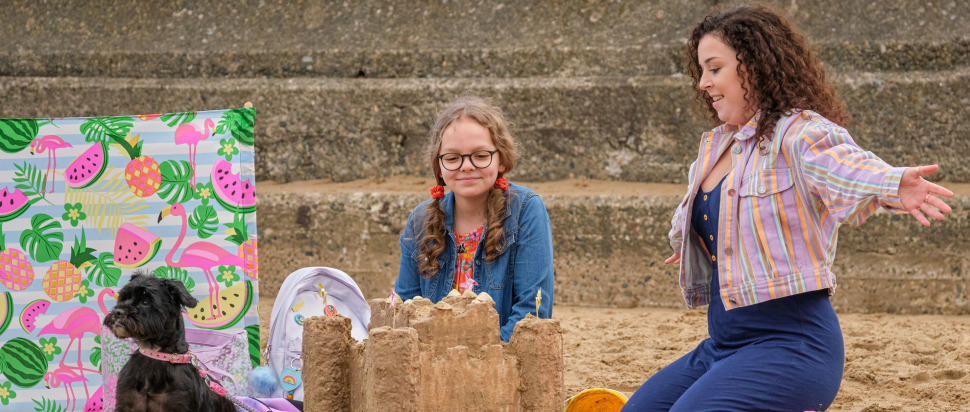How My Mum Tracy Beaker captured the hearts of 90s kids
Kids' TV heroine Tracy Beaker has made a triumphant return to the BBC, but My Mum Tracy Beaker's success isn't all 90s nostalgia. The original show's underlying issues of social mobility, sexuality and class have been brought to the surface in this reboot
Last month, the CBBC channel launched a reboot of their naughtiest noughties character: Tracy Beaker, and the viewing public ate it up. My Mum Tracy Beaker is a three-part drama based on the book by Jaqueline Wilson. Launching on Valentine’s weekend, it racked up an impressive 2.1 million streams and counting. "These viewing figures are extraordinary,” Patricia Hidalgo, director of children’s and education programmes at BBC, told the Metro.
It seems lots of you tuned in to check up on your favourite bolshie heroine. So what was the pull? It’s surely not lockdown boredom alone.
For the uninitiated, the original series – The Story of Tracy Beaker – centred on the eponymous fiery kid and her various escapades at a children’s care home. We followed her as she navigated the challenges of growing up in care, through numerous fostering breakdowns and the heartbreak of fantasizing that her mum, supposedly a Hollywood superstar, would one day whisk her away.
Inequality was inherent in the premise (the home in which Tracy is housed is nicknamed the “dumping ground”), but it’s hard to recall any obvious references to inequality in the initial programme; social injustice wasn’t its focus. This time around with My Mum Tracy Beaker, the writers haven’t shied from class commentary.
We meet Tracy living on a council estate with her ten-year-old daughter, Jess. Despite having her own book published, Tracy juggles three jobs to make ends meet. The storyline unfolds as Tracy becomes romantically involved with her old friend Sean Godfrey, who’s now a famous footballer. He spoils her, flashes his wealth and even buys her a pink Cadillac – a nice nod to the original story.
Class also comes up in Tracy’s lifelong rivalry with Justine Littlewood, her chief antagonist in the original series. While Tracy is happy, yet undoubtedly struggling, in her council flat, Justine boasts about her first-class honours degree and successful business, true to character. The themes of wealth inequality run deeper when we learn that Jess’s friend, Tyrone, misses out on opportunities due to his mum selling his possessions.
The new series seems to respond to the criticism from care leavers who say at worst, the original books and program glamourised growing up in care and at best, the issues were oversimplified – even for a young audience. One such care leaver, Ashley Cameron, one-time researcher for former Scottish Labour leader Kezia Dugdale MSP, summed it up well in a 2018 tweet: “The amount of times I was asked ‘is your life like Tracy Beaker?’ was infuriating.” Then again, others claim Tracy’s circumstances in the new series are yet another missed opportunity to demonstrate a different path for care leavers.
It’s not just a thoughtful foregrounding of Tracy’s class that gives the new show resonance, though. There’s a definite thread of feminism throughout, despite the pitting of Tracy and Justine against one another (it seems fresh perspectives can’t solve 20 years of resentment.) Tracy constantly reiterates that the right men are wonderful extras, ultimately demonstrating that she’d rather be alone than settle for poor treatment. Of course, this isn’t groundbreaking feminism – but it is a positive message for younger viewers all the same.
Other topics that seem wildly out of the realm of children’s TV include Justine’s inferred fertility issues and the candid display of Tracy’s depression. The original series, too, touched on many boundary-breaking topics within kids’ TV such as anger issues, grief and disability. The progression to today’s issues seems natural and refreshing all the same.
The highlight of the series is undoubtedly the celebration of Tracy’s adoptive mum, Cam, and the decision to celebrate her true sexuality, which was hidden in the original show. Wilson herself has stated she always intended for Cam to be gay. A fact that would have been unimaginable for the original series to explore in the shadow of Section 28. When Cam gets to marry the woman of her dreams, it’s an understatement to say it’s an emotional watch. Queer love is rarely shown on TV, not least on TV aimed at children. This display of affection, kissing and all, is wonderful to witness.
My Mum Tracy Beaker’s progressive stance on class, gender and sexuality has not been at the expense of its nostalgic charms. Gone are Nick Sharrat’s colourful illustrations and the show’s goofy wobble-board sound-effects during scene transitions, but there’s still something magic about this series. The pleasure of watching these three episodes is like the joy of checking in with an old friend, safe in the knowledge they’re safe, well and happy.
My Mum Tracy Beaker is available to stream on iPlayer
